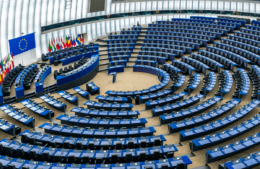Erzincan: Armenian Gravestones Removed as Armenian Heritage Continues to Disappear
- (0)

Agos published this photo of the scattered remnants of the gravestones (Photo: Agos)
By Uzay Bulut
The Armenian Weekly
Gravestones believed to be removed from the Armenian cemetery in the Beybasi neighborhood in the city of Erzincan were recently discovered scattered nearby, Istanbul-based Agos newspaper reported.
How were they discovered? By chance, while making room for a new field in the city.
The gravestones, which have Armenian cross-stones (khachkars) and letters on them, together with human bones, have been removed and scattered around the area for years. Some locals told Agos that there is also an Armenian church in the city, though it has largely been destroyed over the years. Today only the church’s foundation remains.
Erzincan (Yerznka): A Historical Background
Erzincan, or Yerznka in Armenian, is a city in the Armenian highlands in eastern Turkey. It was absorbed into the eastern Roman (Byzantine) Empire following the formal division of the Roman Empire in the fourth century. In the eleventh century, the Turks invaded the region. Coming from the steppes of Central Asia, Seljuk Turks targeted Anatolia and started conquering it with the Battle of Manzikert or Malazgirt in 1071. Even under foreign rule, the city remained predominantly Armenian for centuries.
The Venetian traveler Marco Polo, who visited Erzincan in the second half of the thirteenth century, describes “greater Hermenia” [Armenia]:
“This is a great country. It begins at a city called Arzinga [Erzincan], at which they weave the best buckrams in the world. It possesses also the best baths from natural springs that are anywhere to be found. The people of the country are Armenians, and are subject to the Tartar. There are many towns and villages in the country, but the noblest of their cities is Arzinga, which is the See of an Archbishop.”
In his geography, the Mu’jam al-Buldan (compiled around 1224-8) Yaqut al-Hamawi describes Erzincan:
“Erzincan is one of Armenia’s most beautiful, famous, pleasant, active and populated cities… The majority of the population is Armenian. There are also Muslims, who are the local elite (a‘yan ahliha). Wine-drinking and inappropriate behavior are open and widespread. I do not know of anyone of note from this city.”
The scholar Rachel Goshgarian explains: “It should come as no surprise that an Arabic-speaking Muslim traveler to Erzincan might not have come into contact with (or might refrain from elaborating on) the active Armenian, Christian intellectual life of the city. During the 13th century, the region of Erzincan had several active monasteries (with scriptoria), including those at Avag, Lusavoric, Surb Kirakos, Surb Minas, Surb P‘rkic and Tirašen. Because of its geographical position, its importance as a city of trade, and perhaps simply due to the fact that there were so many Armenians and Armenian monasteries there, Erzincan was an important Armenian intellectual center in the 13th century.”
The Islamic invasion of Asia Minor was completed by the Ottomans. And Erzincan was seized by Ottoman Turks in 1514. Armenians as well as other Christians and Jews became “dhimmis”, third-class, barely “tolerated” people in their dispossessed land, under the Ottoman rule. The demography of the region was changed through methods including forced conversions to Islam or pressures such as heavy taxation from non-Muslims, called the jizya tax. However, the city still had a sizable Armenian community.
The Armenian Genocide
According to book The Armenian Genocide: A Complete History by Professor Raymond Kévorkian, Erzincan had 66 Armenian villages and a total Armenian population of 37,612 before the Armenian Genocide.
“The district’s Kemah gorge served as a killing field… The April 1915 order to collect arms was executed with extreme violence and accompanied by torture, bastinados, and arrests. None of the villages on the plain of Erzincan were spared these operations. On Sunday, 16 May, the last service was celebrated in the cathedral of Erzincan…. the authorities had confiscated three of the city’s four churches. Erzincan’s Armenian quarter was now transformed into a veritable chaos; its schools and churches were systematically pillaged. The men from the households on the plain were methodically killed on Sunday, 23 May, and Tuesday, 25 May, while the women and children were sent to Erzincan’s Armenian cemetery… The men were then executed in small groups—they were either shot or had their throats cut in trenches that had been dug in advance,” Kévorkian writes in his book.
Forced conversion to Islam was also a common method used to destroy the Christian Armenian identity. But in many cases, even conversion to Islam was not enough to save Armenians. Professor Matthias Bjørnlund writes in his article “‘A Fate Worse Than Dying’: Sexual Violence” during the Armenian Genocide:
“Naturally, conversion to avoid persecution or destruction was not a desirable option as it evoked fears of divine punishment and social exclusion among the usually very religious Armenians, where martyrdom, not surrender, was highly valued. But as the examples show, they had little choice. That choice, however, was far from always offered; in fact, the authorities often turned down desperate requests to convert, preferring to have the Armenians killed. Missionaries Wedel-Jarlsberg and Elvers witnessed and described just how desperate the situation was for the surviving Armenian women in Erzincan, telling about a woman shouting to them in the street that, ‘We want to become Muslims. We want to become Germans, whatever you want, just save us, they are about to take us to Kemagh and slit our throats’.”
1916 Battle of Erzincan
The battle of Erzincan took place between the Russian Caucasus Army and the Ottoman Third Army on the Caucasus Front in July 1916. “Erzincan is located in Turkish Armenia about a mile from the Euphrates River,” writes the author Anthony J Schmaus. “The Russian advance reached Erzincan on 25 July 1916, and took the city in only two days… The capture of Erzincan also provided proof of the execution there of Armenians by the Turks.”
But when the Russians arrived, the genocide was already completed. Professor Kévorkian writes:
“According to a conscript who survived the massacre, when the Russians arrived in the area in spring 1916, there were only a few dozen women left; they had been taken into households of the gendarmes and the dignitaries with the heaviest responsibility for the massacres, now having finally been given permission to ‘marry’ Armenian women.”
The Armenian Genocide Museum-Institute published photographs that depict the scenes and traces of horrible massacres in the region of Erzincan and Khnus. “The level of decomposition of the bodies of the victims and snow in the pictures show that they could be dated to the second half of the 1915 and the beginning of the 1916, the time when Russian troops advanced in the frontline, which enable for some Russian military photographers and Armenian reporters took photos of those scenes.
The French journalist Henry Barby (1874-1935) wrote that “There were still thousands of human skeletons visible on the mountains and valleys surrounding Erzincan. These remains belonged to the miserable Armenian refugees who in June 1915 had come all the way from Karin, Kharberd, Bayazit and other places and who were killed around Erzincan during the forced exile to Mesopotamia.”
The Russian forces withdrew after the March 3, 1918 Treaty of Brest-Litovsk between Russia and Germany, leaving the Armenians in the region to their fate.
And this fate has remained the same for a century now.
The Armenian heritage in Anatolia and historic Armenia is about to disappear forever. Damaged or destroyed Armenian gravestones and cemeteries have been found in many cities across Turkey. The few remnant Armenian churches, schools, and cemeteries are the only reminders of Armenian presence in their native lands.
The greatest hope that could revive the Armenian heritage in the region seems to be the “hidden” or Islamized Armenians whose number is estimated to be between 500,000 to 2,500,000.


















